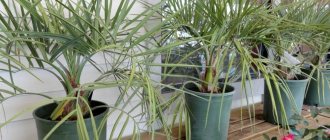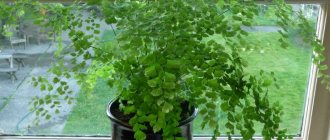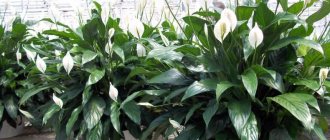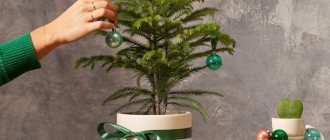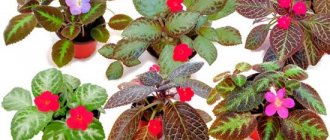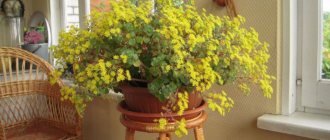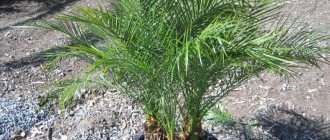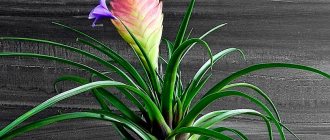Tillandsia is a fantastic plant native to America. Unusual shapes and appearance in a short time made the flower very popular among lovers of unusual flora. Potted and atmospheric subspecies differ from ordinary indoor plants not only in their original appearance, but also in their growing methods.
Despite its exotic nature, tillandsia is quite unpretentious, but requires the gardener to follow certain rules. But don’t worry, it’s not difficult to provide the flower with the necessary conditions, so even a beginner can cope with the cultivation.
Light
It is generally accepted that all air plants should have bright light with occasional direct sunlight. However, air plants can actually grow quite well in a wide range of lighting conditions.
The general rule for choosing lighting for growing at home is to focus on the natural color of tillandsia. The range starts from dark green to light green and then ends with almost white varieties.
Green types will do quite well in areas that don't receive much light on window sills. However, they do not like harsh direct sunlight.
Pro tip: All varieties do not tolerate dark areas well, so this should be avoided for long-term plant health.
If you have an air plant growing behind glass, such as in a terrarium, you absolutely should not place the container in direct sunlight. It doesn't matter what color your plant is - glass amplifies the sun's heat and creates excessively high temperatures.
Indoor Tillandsia species
Despite the numerous species diversity, only a few species of Tillandsia are widespread in home culture and almost all of them are aerial epiphytes of amazing shape.
Spicy herbs on the windowsill
Atmospheric Tillandsia usneoides . The long, bluish shoots appear to be covered in scales, which are actually narrow, small, scaly leaves.
As the shoots grow, they form hanging, tangled garlands that look like moss. The plant has no aerial roots, and its flowers are tiny and inconspicuous, appearing in the axils of the leaves.
Tillandsia usneiformes
In nature, it grows on trees and reaches up to 1-2 meters in length, hanging from branches in the form of a mossy beard, which is typical for the landscapes of Southeast America and Argentina.
English-speaking gardeners call Tillandsia usneoides Spanish moss. Tillandsia usniforme is very easy to grow at home, making it an ideal and unusual houseplant.
Atmospheric Tillandsia ionantha or violet flower (Tillandsia ionantha) is a small epiphyte native to the desert regions of Central and South America.
Tillandsia ionantha, Rubra variety
Forms a compact rosette 8-15 cm high of narrow silver-green curved leaves covered with silvery hairs reminiscent of suede.
The species is represented by numerous varietal forms with leaves of various colors: red, pink, cream, pale orange, silver, violet-red.
The leaves usually begin to gradually change color during the formation of the inflorescence.
Most varieties of Ionantha tillandsia produce blue-purple shoots with yellow or white flowers at the tip. Flowers appear when the plant is mature, which can take anywhere from 4 to 20 years depending on the variety.
Aerial Tillandsia xerographica . Known as the "queen of atmospheric tillandsias" due to its impressive size compared to other species.
It produces long, silver-gray, ribbon-like leaves that curl inward, forming amazingly beautiful rosettes reaching several tens of centimeters in diameter.
Xerographics
The surface of the leaf blade is abundantly covered with tiny silvery-white hairs, thanks to which the rosette shimmers beautifully.
When in bloom, a large red flower forms from the center, which contrasts fantastically with the silvery-white color of the foliage.
Tillandsia xerographica is native to arid and desert areas, so high temperatures, dry air and bright sun do not particularly bother this beauty.
Tillandsia Curly Slim is an unusual hybrid resulting from crossing Tillandsii intermedia and Tillandsii streptophylla.
The epiphyte captivates with its original form of a compact rosette of fleshy, silvery-gray leaves twisted into a spiral.
Tillandsia Curly Slim
Aerial Tillandsia Medusa or Jellyfish Head (Tillandsia caput medusae) . An impressive species native to Central America and Mexico.
Thanks to its narrow, curved leaves, the plant resembles a jellyfish. An additional decoration is the charming pink and purple flowers.
Tillandsia jellyfish
blue Tillandsia or Anita (Tillandsia cyanea Anita ), originally from tropical rainforests, is cultivated at home
Its characteristic feature is the spike-shaped inflorescences with pink bracts and blue three-petaled flowers. The leaves are thin, narrow, dark green, collected in a leaf rosette.
Anita
Caring for this species differs from atmospheric species. When growing the Tillandsia flower, Anita prefers bright places, but without direct exposure to the sun.
For long and beautiful flowering, it needs moist air, so it is recommended to spray the leaves with soft water daily.
The plant prefers moist, neutral soil, and the best results will be obtained when planted in a pot with a mixture of soil, peat and crushed sphagnum moss.
Watering
To avoid harm and to know how to water a flower, use two main methods of watering air plants. The first is to spray the leaves two to three times a week. This is very useful when your plant is fixed in place, such as attached to a wall. Air plants need regular misting or soaking in a water bath.
The second option is to dip the tillandsia flower in a container of water at room temperature. You will need to soak the plant in the container for half an hour or longer.
Soaking in this manner on a regular basis makes caring for these plants more difficult and takes much more time than is really necessary.
When soaking, it is important to shake off excess water and leave to allow the plant to dry completely before night falls and the temperature drops. If there is too much moisture around the plant and it becomes cold, there is a chance of rotting. Therefore, try to water in the morning rather than late in the evening.
How does it reproduce
After flowering, atmospheric Tillandsia produces babies. With their help, the plant is propagated. The babies are disconnected from the mother stem when their size reaches 5 cm in diameter. The shoots are cut off with a sharp knife, and the area is sprinkled with coal flour (both wood ash and activated carbon are used). The sprout is pressed against a support prepared in advance.
Further care is the same as for an adult plant: spraying, feeding, bathing. According to the description, the baby will attach to the support faster if you place sphagnum moss or coconut fibers under it. Tillandsia produce 5-8 children, which makes it easy to propagate the flower even at home.
Flower propagation by children
Humidity
Tillandsia plants are dark to light green in color and generally need more frequent watering and higher humidity levels than gray plants.
If you can apply a mist or soak once or twice a week, you should be fine, and the humidity can be ignored in this case. However, if watering frequently causes you problems, then the compromise should be to keep the humidity fairly high.
Types and varieties
It is quite difficult to give an accurate botanical description of the variety, because most of its representatives have practically no similar external characteristics. Only certain representatives of the numerous genus are suitable for cultivation as a potted crop.
The most popular types of tillandsia:
- Atmospheric - do not have a root system, feed through leaves, and are attached to a vertical support.
- Tillandsia moss or Spanish moss. A plant with long branches and gray leaves. It can grow even without support, the main thing is to hang the plant higher.
- Tillandsia violetflower. Silver leaves, blue-violet flowers. During flowering, the leaves acquire a reddish tint.
- Tillandsia silver. The leaf blades are narrow and long, widening towards the base.
- Potted - the root system is well developed, the rosette of leaves is dense, grown in a flowerpot.
- Tillandsia blue. The leaves are grass-like, the inflorescence appears in summer, has a blue or purple tint.
- Tillandsia Lindena. The closest relative of the Blue Tillandsia. The bracts are soft pink and the flowers are bright blue.
Atmospheric
The root system of the flower is practically absent; the plant feeds with the help of scales that cover its shoots and leaf blades. Poorly developed roots act as a fixative, with the help of which tillandsia is fixed to any surface.
The thin gray-green leaf plates of the flower, growing up to 1 m in length, begin to hang down in a curly cascade as they grow. This species includes several subspecies, the most famous of which is Tillandsia usneiformes, or Spanish moss.
Tillandsia Anita
A unique hybrid variety, distinguished from most of its relatives by the highly decorative, spike-shaped bract. During flowering, small blue-violet flowers consisting of three petals appear along the edges of the pink bract.
Anita
The flowers bloom alternately, starting from the top of the ear. The long and narrow leaves of the flower, the surface of which is covered with small scales, form a dense rosette. The green curved leaf blades at the base have a brownish-red tint. The parent of the variety is Tillandsia Blue.
Tillandsia duera
It is an epiphytic variety of the variety, distinguished by a decorative bract of bright orange color, in the shape of a loose spike. Wide tongue-shaped leaves are collected in a dense rosette around the peduncle.
Duera
"Usnaya"
This is one of the most popular and widely used atmospheric plant varieties and is often also called "old man's beard" or "Spanish moss". Under natural conditions, the flower grows both in partial shade and in sunny areas. It has a rather thin stem 1-2 m long. The leaves of this variety of tillandsia are arranged in two rows, their width is no more than 1 mm and their length is up to 5 cm. The leaves of the plant and its stem have a thick scaly coating, due to which they appear gray. It is recommended to grow this variety using any support so that the stem can descend.
If the plant is provided with proper care, then in the summer you can expect the appearance of a yellow-green bud.
"Gardenera"
It is distinguished by a large and compact rosette, which is formed from arched leaves. The foliage of this variety acts as a “collector of moisture” coming from fog and dew, so after condensation, water droplets quickly fall to the base of the stem and are absorbed by it.
"Violet-flowered"
It is an epiphytic plant because it can grow and establish itself absolutely everywhere. The rosettes of this tillandsia are characterized by compact sizes, they are formed by curved foliage of a silvery hue, which usually takes on a reddish color in summer. The inflorescences are small, spike-shaped and blue-violet in color. Blue Tillandsia is also found.
"Silver"
It is a beautiful evergreen plant whose leaves are distinguished by narrow blades with widening at the base. The foliage of the flower extends from the base and randomly gathers into a curved rosette.
"Jellyfish Head"
It is considered one of the most common varieties of tillandsia, which is characterized by high endurance. The main feature of the plant is its extraordinary shape, which outwardly resembles a bulb with tightly closed leaves at the base. The rosette, as a rule, “hangs upside down” and only some of its branches can branch out to the sides. During the flowering period, the exotic “guest” pleases with bright purple finger-shaped and linear buds, their length is up to 3.2 cm.
"Sitnikovaya"
The main decoration of this flower is the large leaves that gather into a bush-like rosette. The length of the leaves is from 25 to 50 cm. When Tillandsia blooms, it is decorated with a long red bract, on which there are small purple flowers.
"Blue"
This variety is often found on sale. The plant is characterized by a compact rosette formed from curved narrow foliage. The length of the leaves does not exceed 30 cm. They contain so-called xerographics, consisting of various patterns and ornaments. In summer, the plant begins to bloom and produces an elliptical, dense spike along which small blue and purple flowers are located.
Feeding
Feeding at least a few times a year is a good idea for indoor maintenance as it will give you strong, healthy plants in the long run. You can use special cactus or orchid food, or just regular houseplant fertilizer diluted by half (they don't need much).
The only catch is to avoid fertilizers containing boron, copper or zinc, as all three metals are toxic to most tillandsias.
The fertilizer can be applied to the leaves in a spray bottle or in a container of water if you are soaking the plant.
Planting and replanting tillandsia
For young plants grown from side shoots or children, replanting is necessary only after two years. If the bush is purchased in a store with a peduncle, there is no point in replanting the plant. It is important to place the plant in a permanent place and not touch the bush until flowering begins.
The container for tillandsia should be small, wide and shallow. It is necessary to regularly update the top layer of the earthen mixture.
Optimal substrate:
- Leaf soil - four parts;
- Humus - four parts;
- Peat - one part;
- Moss - one part;
- Coarse sand – one part.
Atmospheric plant species are attached to a support, having previously wrapped a bunch or rosette with sphagnum moss, and are not subsequently replanted.
The procedure is carried out as follows:
- The plant is carefully removed from the pot, the roots are freed from the old soil and inspected.
- If rotting and dried roots are found, they are cut with a sharp knife and the cut areas are sprinkled with crushed charcoal.
- A drainage layer of expanded clay and pebbles is placed in a new flowerpot, and a little earth is poured on top.
- The plant is placed in the middle of the container, the roots are straightened and covered with the remaining substrate.
The flower is moistened and placed in partial shade for several days, after which it is cared for as usual.
Temperature
When it comes to temperature requirements, these plants are happy with temperatures ranging from 10 C to 30 C. Some varieties can tolerate lower temperatures, but this is not ideal as it dramatically increases the likelihood of rotting.
Reproduction
Tillandsia uniformis most easily propagated vegetatively. It is enough to cut off young shoots with leaves from the mother bush and strengthen them on a new support. With high humidity, they easily take root in a new place and grow quickly.
Cut off a shoot of the size you need or an epiphyte rosette with or without roots, powder the sections with crushed activated carbon and attach or place them in a new place you need. Tillandsia grows slowly, be patient. Although, with good humidity and proper lighting, soon enough the new shoots will attach themselves to a new support and begin to grow. Congratulations - you have a new specimen in your exotic collection.
Spreading
The air plant can be propagated by seeds, which it can produce at the end of its life cycle, but this usually only works if you have several air plants blooming at the same time so that they can pollinate each other.
In addition, there are special requirements for germination as well as for plant survival into adulthood.
Instead, it will be much easier if you skip all this and wait until the cuttings form at the base of the mother plant. You can leave them so that they form a nice clump, or instead, when they are almost a third smaller than the mother plant, you can carefully separate them and treat them as individual plants.
Flower varieties
Among the many types of atmospheric tillandsia, the following varieties are most suitable for survival at home:
- Silver. The rosette is thickened, the leaves are thin, thread-like, the flowers are small red-blue. It got its name from the bloom on the leaves, which glow silver in the sunlight.
- Head of Medusa. The leaves are plump, tightly curled, tentacle-like. The flower is bright pink with blue buds, flat in shape.
- Mahoid. There are no roots at all, the leaves are narrow with sharp tips, and the leaves are covered with a light white fluff on top. The flowers are small, inconspicuous, yellow.
- Tillandsia violetflower. Externally similar to coral. The rosettes are small in size, up to 5 cm, the leaves are thin, arched, the buds are violet-blue, and the normally green leaves turn pink during flowering.
Tillandsia xerographic
- Bootsy. The leaves are wide at the base with awl-shaped tips of emerald color, intertwined and entangled with each other. The flower is ribbed with a pink center and purple petals.
- Tillandsia juncea. The leaves are reed-like and collected in a rosette. Purple flower.
- Tillandsia bulbosa. The leaves are thin, long, twisting. When the plant blooms, the upper leaves turn red and the flower takes on a lavender hue.
- Tillandsia xerographica is the largest species. Grows up to 1 m in height. The leaves are silvery, curled at the ends. Becomes incredibly beautiful during flowering: the leaf bracts are bright pink, the flower bracts are green-yellow, and the flower itself is purple.
Atmospheric Tillandsia surprises with its beauty and vitality. The species differ from each other in the shape and color of the leaves, sizes, and shades. By purchasing several different varieties, you can create a strange mix without getting your hands dirty in the soil. It is easy to care for plants; the main condition is high humidity and regular spraying.
Plant height
The variety available means height and width may vary slightly between plants. However, air plants are generally not large indoor plants, and they probably won't grow much larger than what you have when you first buy them.
Reproduction of atmospheric tillandsia
If desired, you can grow a large collection of these amazing plants. Moreover, even a beginner can cope with the task. To begin, prepare all the necessary materials.
Plants do not need soil; most often they are attached to bars, driftwood or felt. When creating a composition with a flower, remember that using materials treated with varnish, paint or chemicals is strictly prohibited. After all, the plant will quickly die from contact with them. An ideal option would be a piece of natural tree bark, a fragment of a root or branch, or a small wicker basket. If you plan to hang the stand on the wall, first make a hole in it and thread the wire.
Start propagating atmospheric tillandsia when the babies grow to 5-6 cm in diameter. How to hold an event:
- Cut the babies from the mother plant with a sharp knife, and be sure to treat the cut areas with crushed coal.
- Press the tillandsia to the support with the root collar, root inward. It is advisable to place a little sphagnum moss or coconut fibers between the plant and the stand. This will make it easier for the tillandsia to cling to the support.
- Carefully secure the plant to the stand using soft elastic thread or sheathed wire. To make the composition look impressive, match the threads to the color of the support or tropical beauty.
- Spray the plant with warm water from a spray bottle and then hang it or place it in a permanent place.
In the future, provide young crops with regular care.
Flowers
The photo of tillandsia during flowering captivates with its beauty. But at the same time, it is often bittersweet. On the one hand, this shows that you raised and cared for him correctly and at a good level. On the other hand, it also marks the end of plant life.
It takes many years, but air plants only bloom once, and when they do, the mother plant begins to lose its vigor and deteriorates before dying.
During this die-off period, it will spend all its energy producing as many cuttings as possible for reproduction. Once they have grown to a decent size, they can be separated from the mother plant or left to form an attractive bush.
It all depends on the variety you have, but the flowers themselves can be very short-lived - just a day or so - or they can last a month or more. Despite this, they are often striking, sometimes looking alien-like, but still pleasing to the eye.
When and how does it bloom
Tillandsia Anita - home care
Tillandsia atmospherica blooms once at the age of 2-3 years, after which it begins to reproduce, sending out shoots and, having devoted all its strength to it, dies.
Types of flowers
Tillandsia blooms unusually and beautifully. First, she produces a spike, on which bright buds subsequently bloom one by one. The size and color of the buds depends on the type of flower.
Incredible tillandsia bloom
Flower shapes
The buds of the ear bloom one after another, while the faded buds are not picked, as they look exotic and decorative.
Flowering period
The total duration of flowering can last several months. During the flowering period, you need to monitor air humidity and the condition of the leaves, and carry out regular spraying so that the plant has enough strength to bear offspring.
You should know! The plant, along with its support, is regularly immersed in water, which is why it is better to immediately choose a reliable material for support that will not quickly deteriorate from the abundance of moisture.
Are air plants poisonous?
The good news is that tillandsias are not poisonous to people or most pets such as cats and dogs. The bad news is that their unusual appearance can attract playful and curious pets.
Don't let your pets play with them as their delicate size can cause them to be easily damaged.
Diseases and pests
It is believed that the plant is rarely attacked by pests and almost never gets sick, but gardeners still recommend regularly inspecting the plant in order to promptly identify the problem and eliminate it.
The main danger to tillandsia is scale insects and scale insects. They can be removed from the plant using a soap solution. If the bush is heavily infected, special insecticides are used.
As for diseases, Tillandsia, like many bromeliads, is susceptible to fungal and viral diseases. The leaves become transparent and black spots appear on them. To cure the plant, you need to remove damaged leaves and regularly ventilate the room.
With improper care and maintenance, the plant becomes sick. The main problems appear as follows:
- There are brown spots on the tips of the leaves. They occur when watering regimes are not followed and hard water is used. The moistening period is reviewed and only melted or filtered water is used.
- No flowering. The main reason is lack of light and low air humidity. The plant is moved to a warm place, additional lighting is installed and sprayed regularly.
- The leaves have turned brown. It happens due to sunburn. At midday, the pot is shaded from the direct rays of the sun.
- Leaves fall due to sudden temperature changes. Urgently change the temperature regime, protect it from drafts, otherwise the plant may die.
- The plant dies and rots without flowering. This happens if tillandsia was planted in ordinary soil, waterlogged and when a large amount of fertilizer was applied. It is treated by urgent transplantation into new soil.
The plant can not only get sick, but also be attacked by various pests , such as mealybugs and scale insects. To combat them, in case of mild infection, wipe the leaves with a cotton swab dipped in a soap solution. In case of severe damage, insecticidal preparations are used.
Often the cause of plant infection is improper maintenance conditions: high or, conversely, low temperature, dry air, lack of air.
Why doesn't tillandsia bloom?
The main reason for the lack of inflorescences is non-compliance with the rules of growing the plant. Buds do not form in insufficient light and insufficient air humidity.
It is also important to remember that an adult plant that has already bloomed once will no longer form buds, it will slowly fade.
In general, tillandsia is an unpretentious plant belonging to the bromeliad family. Features of care and cultivation depend on the type of plant. The most difficult thing is to create a comfortable microclimate for atmospheric species. They require high air humidity, which only occurs in florariums. Potted tillandsia species are less demanding; they require moderate and regular watering, bright light without direct sunlight and additional nutrition during the period of active growth.
Features of placement
You can grow these plants anywhere. However, make sure that any container you place it in has free air flow, i.e. no closed bottles.
Also, if you want to hold it in place with wire, avoid superglue and wire containing copper. Both can cause severe damage or even kill the plant.
Description and photo
Usnaea Tillandsia is the most popular of the atmospheric Tillandsias. It also has other popular names. For example, Spanish moss. In fact, it is not moss at all, and it reproduces not by spores, but vegetatively - from seeds. Light flower seeds are carried by the wind in all directions, fall on fertile soil and form new sprouts. But for its appearance and ability to take root where other plants cannot survive, tillandsia was dubbed Spanish moss. As the plant grows, the lower stems die off and new ones grow upward.
Tillandsia usneiformes is a typical opportunistic plant. It wraps its thin soft branches around a neighboring living plant - a bush or the trunk of a huge tree.
- Thread-like leaves up to 8 cm long and 1 mm wide, arranged in two rows on thin, highly branched stems covered with scale-like whitish hairs.
- The leaves and stems are densely covered with gray scales. Due to their reflective properties, tillandsias appear gray-silver.
- This plant has no roots, it simply hangs from the trees in whole lacy cascades of not very long shoots, clinging to the bark of the trees with its thread-like thin stems.
- The length of the shoot is no more than 20 cm, but there are so many of them that, even when they die, they do not disappear anywhere. Young shoots grow on old ones and over time they grow and intertwine so that they form huge silvery beards up to 3 m long. Hence, another name for Usneiform Tillandsia is Old Man’s Beard.
When strong winds blow, the long beards of tillandsia cling to neighboring trees, the shoots get stuck in their crown and continue to grow there. It is surprising that this lace plant also blooms with yellowish-light green flowers in the summer months.
Tillandsia absorbs nutrients and moisture from the air. That is why these epiphytes grow in places with high environmental humidity.
The most beautiful specimens of Usneiform Tillandsia are found in Bolivia at an altitude of 3.5 thousand m above sea level. Where the silvery beards of old people grow, the surrounding landscape takes on an unusually fabulous look, and on moonlit nights – even mystical.
Interesting
Tillandsia moss is called Louisiana moss for its external resemblance to mosses and the geography of its most common place of growth: Louisiana is one of the southern American states in the swampy mouth of the Missouri River, where Tillandsia moss forms large thickets on the branches of swamp cypresses and oaks. And the plant was named Spanish moss or Spanish beard allegedly by the Indians, who, upon seeing the Spanish conquistadors, were amazed by the luxurious vegetation on the faces of the arriving conquerors, because beards do not grow well among representatives of Indian nations.
Otherwise, this plant is called old man's beard, angel hair, Spanish or Louisiana moss. It comes from the subtropics, most common in the southern states of America, Argentina and Chile. Tillandsia usneiformes is a flowering plant that, despite one of the variants of the name, has nothing to do with mosses.
Flower care: summary
- Medium Light Level – This is an adaptable houseplant that can grow equally well in moderately lit or brightly lit spaces. Avoid prolonged storage in the shade.
- Moderate watering - Water well by misting several times a week, or by dipping the entire plant in a bowl of water.
- Temperature - They need a temperature between 10 C and 30 C.
- Feeding – Feed once every two to three months year round to keep the plant looking healthy. Add fertilizer to a bowl of water.
Rules of care
To figure out how to care for tillandsia, you need to determine its type. To do this, when purchasing, you need to pay attention to how the plant is planted. Potted species with green foliage are sold in small containers filled with peat. Atmospheric varieties have silvery leaves and are most often sold together with a piece of bark or in a glass container.
Lighting
Green varieties are shade-loving, so windows of western, northern or eastern orientation are suitable for them. But for potted plants, slight shading or light diffusion will be required in any case. You can place the flower in the shade of taller neighbors or protect the pot with tulle.
Gray subspecies grow well without additional shading or lightening. Eastern and western window sills are suitable for them. Epiphytes can be placed in the back of the room, as artificial light is enough for them.
Temperature
Epiphytes are more resilient and less responsive to changes and drafts. They grow well in the range from +12 to +35 °C.
Potted plants are more sensitive and prefer the range from +18 to +26 °C. Sharp jumps of 5–6 °C can be detrimental for them.
Watering mode
Potted varieties are watered using the classical method. At the same time, make sure that the water moisturizes not only the soil, but also the leaves. Excess moisture must be removed.
Atmospheric epiphytes are usually not watered, but rather sprayed. In some cases, it is recommended to completely immerse the plant. To do this, the tillandsia along with the attachment point is immersed in water for 1–2 minutes. Then pull it out and allow the excess liquid to drain.
You can tell that a plant needs watering by looking at its leaves. Leaf blades curl or droop. If the leaves of potted varieties are completely curled, then the flower along with the container is immersed entirely in water for several minutes.
Air humidity for potted varieties should be within 60%, for atmospheric ones at least 80%. You can increase the humidity by spraying or using a humidifier.
Do not spray or water plants at temperatures below +16 °C.
Fertilizer and feeding
It is recommended to feed tillandsias with liquid foliar sprays. Exotics are also fed by immersing the entire plant in dissolved fertilizers.
Fertilizing can be applied only in summer and spring, when the plant is actively growing and developing. Fertilizers are used maximum once every 3–4 weeks.
You cannot use nitrogen-containing fertilizers, boron fertilizers and organic matter. Even in small doses, nitrogen has a detrimental effect on the plant.
Atmospheric varieties do not actually require fertilizers. The leaves and stems absorb all the beneficial substances from the air and water, as well as from slowly decomposing coconut fibers and bark.
Bloom
Not all types of tillandsia bloom at home, but some varieties delight their owners every year. Flowering usually begins in mid-summer and, depending on the species, can last from several days to two months.
To achieve the formation of flower stalks, it is necessary to provide the plant with optimal conditions. Observe the watering (spraying) regime, avoid sudden temperature changes and drafts. You should also take into account the species characteristics and do not plant potted hybrids in dense soils.
Growing problems
My flower is not growing - Unless the plant is very young, there is usually little to no growth and this is not a cause for concern. In fact, we'd go so far as to say that it's not a problem, and if your plant is healthy, just enjoy your little houseplant.
Brown Leaves – Large areas of leaves that have turned brown (not just the tips) are a sign of various types of damage or abuse. The leaves are quite small anyway, so some damage from home care is indeed common.
You can cut off the brown pieces. Make sure you cut at an angle rather than straight across so that what's left of the sheet blends in with the others.
Leaves are curling – When leaves suddenly curl or wrinkle, it means it urgently needs water. Leaf curling is a last-ditch effort to prevent water loss by reducing leaf surface area due to drafts and light.
To remedy this, water the plant well and consider a long soak in a bowl of water to hydrate the plant. The leaves should open completely within a few days.
What is the difference between green and gray tillandsias - There really isn't much difference. Although greener species have fewer trichomes (tiny structures on leaves that help the plant trap and absorb moisture and nutrients) than grayer air plants.
In terms of care requirements, greener plants will likely need more frequent watering and will do better in shadier areas and terrariums. While grayer types will benefit more from higher humidity areas and lighter areas in the home.
What should I do with my plant's roots - Most Tillandsia species are epiphytes, which simply means that they grow on the surface of another plant. To help them stay attached, they tend to grow superficial supporting roots that help them "hang on."
When air plants are grown indoors as houseplants, the roots last very little, so they can be trimmed or removed if they are not desired. However, there is equally nothing wrong with leaving the roots alone.
Is my plant turning brown and soft? - Both symptoms are a clear sign of plant rotting. Watering too frequently, doing it late in the evening when temperatures are cooler, or exposing it to very cold temperatures will all lead to the very real possibility of your plant dying.
Features of caring for tillandsia at home
Lighting and temperature
The amount of light needed depends on the species. Thus, atmospheric tillandsias with silver-colored hard leaves require a brighter exposure indoors and can withstand direct sunlight. For example, Tillandsia xerographica can be grown in full sun.
Shade-tolerant indoor plants
Species with green color and herbaceous foliage grow best in diffused light or light partial shade, and direct exposure to midday summer rays leads to burns.
The color cast of many species also depends on the amount of light they receive.
If the flower is located near a window, then its leaves acquire a pink tint, and in some cases even reddish. If a flower is grown in the back of a room with a lack of light, then the leaves always remain green.
On the left is a flower that receives the maximum amount of bright sunlight.
In principle, an area next to a south window or east and west exposure is perfect for growing indoor tillandsia. In winter, it is recommended to move the plant to the windowsill of a south window or use a phytolamp.
The plant can also be grown entirely under artificial lighting, which uses a fluorescent lamp that emits the right amount of ultraviolet light.
The optimal temperature for caring for atmospheric tillandsia is 18–24 °C in summer and about 15-16 °C in winter, but not lower than 10-14 °C.
The plant does not like drafts, so in summer do not place it near fans or air conditioners.
However, fresh air has a beneficial effect on the development of the epiphyte, so in the warm season it is useful to take the tillandsia flower out into the open air.
Watering tillandsia at home
An important factor in caring for tillandsia is proper watering. The epiphyte needs special irrigation, which is carried out in two ways.
The first method is to spray the plant with a spray 2-3 times a week. It is especially important to moisten air tillandsia so often in hot summers or winters in a room with heating devices.
Indoor grapes, care
A special air humidifier perfectly imitates the natural environment. In winter, in a cool room, it is enough to spray once every 10-14 days.
In case of severe drought, the epiphyte begins to draw water through its small roots, like a regular houseplant, or extract it from internal reserves stored in the leaves.
Second way. Every three weeks, indoor tillandsia is immersed in water for half an hour or an hour, and then the excess water is allowed to drain by shaking the plant several times, holding it at the base of the rosette.
Soaking in water
It is advisable for the epiphyte to dry completely within 1-3 hours. If water accumulates and remains in the leaf rosette for a long time, this can cause the development of rot.
For this reason, it is recommended to water in the morning, and then dry the atmospheric beauties on a towel or dish in bright, diffused light.
Another lesser-known method of watering is to place the epiphytes on a sieve and hold them under running tap water (provided that it does not contain bleach or salts).
If you want the leaves in the rosette of Tillandsia xerographica to be tightly compressed, then limit the irrigation. A loose leaf rosette is obtained under normal watering conditions.
Tillandsia Anita is watered from above, like a regular plant, twice a week during flowering, and in winter in a cool room - on average every 10 days, as the top layer of soil dries.
It is not recommended to place the pot near heating appliances and radiators. Excess water is poured out of the pan.
Attention! The type of water used for irrigation is very important. Under no circumstances should you use distilled water as it does not contain enough nutrients and minerals that your green pet needs.
Additionally, distilled water sucks nutrients out of atmospheric tillandsia through osmosis.
Bottled drinking water is best, but filtered or settled tap water with minimal chlorine will also work.
Aerial Tillandsias
Ideal for watering tillandsias is rain and other natural water, which contains the required amount of nutrients and has a well-balanced pH.
Feeding and replanting tillandsia
Epiphytes do not have high nutritional needs - it is enough to feed them every three weeks (from spring to late summer) with highly diluted doses of fertilizers intended for orchids.
Atmospheric species are fed by spraying water with fertilizer on the leaves. Anita growing in the soil is fed once every 2-3 weeks during watering.
Spray feeding
Fertilizing is not necessary if rain, lake or other natural water is used for irrigation, since they are already rich in nutrients.
Traditional replanting is only relevant for blue Tillandsia Anita, which is usually replanted once in the second year of cultivation after flowering. This species prefers fertile humus substrates with the addition of peat and sphagnum moss.
Transplanting cacti at home
On sale you can see ready-made soil for bromeliads, which is quite suitable for growing Anita. Be sure to add a drainage layer of expanded clay at the bottom of the pot. The neck of the plant should not be buried.
In atmospheric tillandsias, instead of transplanting to a new place, their lateral shoots are usually placed.
Tillandsia propagation
The easiest and fastest way to propagate an epiphyte is to separate young, lateral shoots from the mother plant. After the first flowering, tillandsia begins a reproduction cycle, forming lateral shoots in the root zone.
In some species they are formed near the peduncle. When the “babies” grow up, reaching 1/3 of the height of the mother plant, they are separated with a sharp and sterile knife.
Separation of lateral processes
You can do without a knife by simply tearing off the shoot from the tillandsia. Once grown, it comes off easily. The sections are treated with crushed charcoal.
Separated shoots
Tillandsia “babies” are planted and grown in the same way as an adult plant, depending on the species. In principle, the propagation technology is similar to such bromeliads as Vriesia, Guzmania, Aechmea, etc.
If the lateral shoots are left on the epiphyte, then after a few years the plant will grow in diameter in different directions. This is the form in which Tillandsia is most often found in the wild.
Tillandsia in the interior
Interest in these amazing plants has increased significantly in recent years.
Atmospheric tillandsias are versatile in terms of design use. They are so unpretentious in this regard that they can grow on any surface provided the necessary humidity.
The plant below, at the base of the leaf rosette, has a stratum corneum that withstands contact with the glue.
Using special silicone, the epiphyte can be glued to any surface, which is often used to create interesting compositions, for example, growing tillandsia upside down.
Growing on a tree
You can also attach the plant to a tree with aluminum wire, wrap it in coconut fiber around the bark, or glue it to a stone, giving the composition a natural look. You can also grow epiphyte in an empty coconut.
Mini-landscapes in glass using colored sand, moss, shells, glass beads, and decorative stones are popular.
Such a composition can consist of one or several plants. Mini-orchids complement tillandsia well in such landscapes.
These amazing epiphytes can also be grown in various types of terrariums or aquariums where the habitat conditions are more controlled.
Problems in caring for tillandsia at home
In fact, overwatering and poor drying after soaking are one of the main causes of plant loss, as leaf rosettes are susceptible to rot.
A symptom of excess moisture is darkening and subsequent softening of the base of the rosette due to the development of wet rot, the appearance of black spots on the foliage.
Fungal rot on a leaf
As the disease progresses, indoor tillandsia begins to lose its lower, darkened leaves and the entire leaf rosette may begin to disintegrate.
The socket falls apart
At the first signs of the disease, it is necessary to remove the affected leaves, but it is easier to prevent the disease than to stop it.
The epiphyte may also suffer from what is called dry rot, which occurs when there is no good air circulation.
Dry rot
Water deficiency leads to leaf dehydration, which manifests itself in drying of the tips of the foliage, curling and loss of elasticity. Immersion watering for an hour will restore a wilted plant.
If the tips of the air tillandsia turn brown, this may be a sign that there is a large amount of chlorine and/or salts in the watering water.
Mold in a flower pot
If the plant develops only bracts without flowers, then the cause may be a lack of light, low air temperature or too dry air.
Dry areas can also cause problems with spider mites. In case of damage by these pests, it is recommended to use environmental acaricides for indoor flowers for treatment.
Video about Tillandsia
This unique member of the bromeliad family can become the crown jewel of any indoor plant collection.
Author: Irina Baltaga Updated: December 14, 2020
- Little ones
- Unpretentious
- Bromeliads
- Exotic
Tillandsia Photos
Soil and fertilizers
Tillandsia usneiformes loves light, well-permeable, neutral or slightly acidic soil. To be replanted as needed, when the bush becomes too voluminous or the roots begin to appear from the pot.
The top layer of the substrate needs to be renewed annually; due to the poorly developed root system, in this case the pot needs to be wide, but not deep. You can buy the soil at the store or prepare it yourself:
- crushed peat (2 parts);
- leaf humus (1 part);
- fern roots (1 part);
- sphagnum moss (1 part);
- pine bark (1 part).
Tillandsia usneiformes needs to be fertilized 3 times a month using flower fertilizers; the dosage should be reduced by four times compared to that indicated on the package.
In this case , fertilizer for orchids can also be used; this can be a substrate or foliar feeding, i.e. spraying the leaves. Fertilizers should contain little copper; high concentrations may be toxic to bromeliads.
Description: general characteristics
Under natural conditions, representatives of the Tillandsia genus, of which there are about 700 species, grow in various climatic conditions of Chile, the USA, Mexico and Argentina. The genus was named by the great Carl Linnaeus in honor of the Finnish professor of medicine Elias Tillands. Translated from Swedish, till lands translates as “by land”, “by land”. Only a few species are grown in indoor floriculture.
The genus Tillandsia united two groups of plants that differ significantly from each other:
- Potted (green tillandsias). Plants develop in ordinary soil and produce beautiful rosettes of leaves that serve as a spectacular backdrop for the inflorescences.
- Epiphytic tillandsias are quite rare, slightly capricious plants that attract not with their flowering, but with their unusual foliage. Some varieties have a hard stem and are completely devoid of it. Epiphytes are distinguished by oblong narrow leaves up to 25 centimeters long, and their width barely reaches one centimeter. Foliage color ranges from light gray to rich green.
Flat leaves with scales form rosettes of potted tillandsias. Some varieties have long and smooth leaves. Bright pink bracts form a large inflorescence that looks like a spike. Green Tilandsias live in houses for no more than five years.
